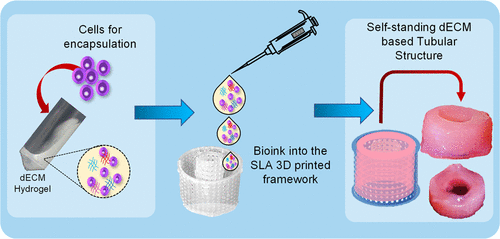当前位置:
X-MOL 学术
›
ACS Appl. Bio Mater.
›
论文详情
Our official English website, www.x-mol.net, welcomes your feedback! (Note: you will need to create a separate account there.)
Integrated 3D Printing-Based Framework—A Strategy to Fabricate Tubular Structures with Mechanocompromised Hydrogels
ACS Applied Bio Materials ( IF 4.7 ) Pub Date : 2021-08-26 , DOI: 10.1021/acsabm.1c00644 Sriya Yeleswarapu 1 , Shibu Chameettachal 1 , Falguni Pati 1
ACS Applied Bio Materials ( IF 4.7 ) Pub Date : 2021-08-26 , DOI: 10.1021/acsabm.1c00644 Sriya Yeleswarapu 1 , Shibu Chameettachal 1 , Falguni Pati 1
Affiliation

|
Several hollow organs perform various crucial functions in the body and must be replaced, repaired, or augmented in many disease conditions. Fabrication of tissue analogues to these hollow organs is incredibly challenging. Still, recent advancements in biofabrication have allowed researchers to pursue the development of several hollow organs such as blood vessels, esophagus, trachea, urethra, and others. Materials like collagen, alginate, elastin, silk, fibrin, etc., have been predominantly used for organ development. However, the focus has been duly shifted toward decellularized extracellular matrix (dECM) to develop tissue-specific hydrogels because they provide relevant biochemical cues to promote cellular activity. Still, the dECM-based hydrogels are mechanically weak to fabricate self-supporting tubular structures. Here, an innovative approach using the stereolithography apparatus (SLA) 3D printed framework has been implemented to achieve a self-supporting tubular structure using caprine esophagus muscle dECM hydrogel. A significant improvement in the mechanical stability of the biofabricated tissue has been observed within 7 days of culture. Interestingly, the encapsulated L929 mouse fibroblasts transdifferentiated into myofibroblasts because of the cues provided by the muscle dECM. Overall, the potential of an SLA-based 3D printing strategy to fabricate frameworks, especially for fabricating tubular organs/tissues using mechanocompromised hydrogel, has been demonstrated here.
中文翻译:

基于集成 3D 打印的框架——一种使用机械性能受损的水凝胶制造管状结构的策略
几个中空器官在体内执行各种重要功能,在许多疾病情况下必须更换、修复或增强。制造这些中空器官的组织类似物是非常具有挑战性的。尽管如此,生物制造的最新进展仍使研究人员能够开发多种中空器官,例如血管、食道、气管、尿道等。胶原蛋白、藻酸盐、弹性蛋白、丝绸、纤维蛋白等材料已主要用于器官发育。然而,重点已经适当地转移到去细胞化细胞外基质 (dECM) 以开发组织特异性水凝胶,因为它们提供了相关的生化线索来促进细胞活性。尽管如此,基于 dECM 的水凝胶在制造自支撑管状结构方面的机械性能很差。这里,已经实施了一种使用立体光刻设备 (SLA) 3D 打印框架的创新方法,以使用山羊食道肌肉 dECM 水凝胶实现自支撑管状结构。在培养 7 天内观察到生物制造组织的机械稳定性有显着改善。有趣的是,由于肌肉 dECM 提供的线索,封装的 L929 小鼠成纤维细胞转分化为肌成纤维细胞。总体而言,这里已经证明了基于 SLA 的 3D 打印策略制造框架的潜力,特别是对于使用机械受损水凝胶制造管状器官/组织的潜力。在培养 7 天内观察到生物制造组织的机械稳定性有显着改善。有趣的是,由于肌肉 dECM 提供的线索,封装的 L929 小鼠成纤维细胞转分化为肌成纤维细胞。总体而言,这里已经证明了基于 SLA 的 3D 打印策略制造框架的潜力,特别是对于使用机械受损水凝胶制造管状器官/组织的潜力。在培养 7 天内观察到生物制造组织的机械稳定性有显着改善。有趣的是,由于肌肉 dECM 提供的线索,封装的 L929 小鼠成纤维细胞转分化为肌成纤维细胞。总体而言,这里已经证明了基于 SLA 的 3D 打印策略制造框架的潜力,特别是对于使用机械受损水凝胶制造管状器官/组织的潜力。
更新日期:2021-09-20
中文翻译:

基于集成 3D 打印的框架——一种使用机械性能受损的水凝胶制造管状结构的策略
几个中空器官在体内执行各种重要功能,在许多疾病情况下必须更换、修复或增强。制造这些中空器官的组织类似物是非常具有挑战性的。尽管如此,生物制造的最新进展仍使研究人员能够开发多种中空器官,例如血管、食道、气管、尿道等。胶原蛋白、藻酸盐、弹性蛋白、丝绸、纤维蛋白等材料已主要用于器官发育。然而,重点已经适当地转移到去细胞化细胞外基质 (dECM) 以开发组织特异性水凝胶,因为它们提供了相关的生化线索来促进细胞活性。尽管如此,基于 dECM 的水凝胶在制造自支撑管状结构方面的机械性能很差。这里,已经实施了一种使用立体光刻设备 (SLA) 3D 打印框架的创新方法,以使用山羊食道肌肉 dECM 水凝胶实现自支撑管状结构。在培养 7 天内观察到生物制造组织的机械稳定性有显着改善。有趣的是,由于肌肉 dECM 提供的线索,封装的 L929 小鼠成纤维细胞转分化为肌成纤维细胞。总体而言,这里已经证明了基于 SLA 的 3D 打印策略制造框架的潜力,特别是对于使用机械受损水凝胶制造管状器官/组织的潜力。在培养 7 天内观察到生物制造组织的机械稳定性有显着改善。有趣的是,由于肌肉 dECM 提供的线索,封装的 L929 小鼠成纤维细胞转分化为肌成纤维细胞。总体而言,这里已经证明了基于 SLA 的 3D 打印策略制造框架的潜力,特别是对于使用机械受损水凝胶制造管状器官/组织的潜力。在培养 7 天内观察到生物制造组织的机械稳定性有显着改善。有趣的是,由于肌肉 dECM 提供的线索,封装的 L929 小鼠成纤维细胞转分化为肌成纤维细胞。总体而言,这里已经证明了基于 SLA 的 3D 打印策略制造框架的潜力,特别是对于使用机械受损水凝胶制造管状器官/组织的潜力。


























 京公网安备 11010802027423号
京公网安备 11010802027423号